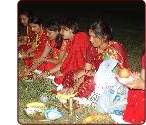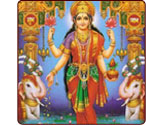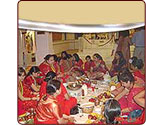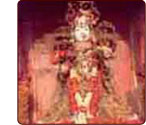4/5 SEP 2016 HARTALIKA TEEJ
Hartalika Teej Vrat is observed in the month of Bhadrapad, and this year it falls on September 4. On this day, statues of Lord Shiva and Goddess Parvati made out of sand, are worshipped for marital bliss and progeny.
A pooja done with complete rituals on Hartalika Teej is believed to shower prosperity on a married woman, and bless an unmarried girl with a desirable match.
This year, the auspicious time for doing pooja is as follows:
Mahurat: 6:44 am to 09:17 am
Duration: 2 Hours 32 Mins
Pooja Ritual
Take an early morning bath and get dressed in fine clothes. Mix Ganga water in sand to build statues of Lord Shiva & Goddess Parvati, and worship them. The legend of Hartalika should also be narrated during the pooja. (This is given in the next slide)
Fast for the entire day, avoiding even water.
You can chant the following matras too:
For Goddess Parvati
Om Shivay Namh
Om Parvatay Namh
For Lord Shiva
Om Haray Namh
Om Maheshwaray Namh
Click on the next slide to know the legend of Haratalika…
Haratalika is derived from the words 'Harat' and 'Aalika' which literally means 'abduction' and 'female friend' respectively. According to the legend, a friend of Goddess Parvati took her to a forest so that her father could not marry her off to Lord Vishnu against her wishes.
In the forest, Parvati built an idol of Lord Shiva out of sand, and started praying. Seeing her resolution, Lord Shiva was pleased and granted her a wish. Parvati in turn asked Lord Shiva to be her husband.
Click on the next slide to know different variations of this festival in India…

Hartalika teej celebration
There are several regional variations of this Teej ritual, but the essence behind it remains the same. Teej festivity is observed with much fanfare in North Indian states of Rajasthan, Uttar Pradesh, Madhya Pradesh and Bihar.
In Karnataka, Andhra Pradesh and Tamil Nadu, Hartalika Vrat is known as 'Gowri Habba'. It is a significant festival where women seek blessings of Goddess Gauri (Parvati).
Teej Puja Process
 Teej Puja is a vital part of Teej celebration. Women, both married and unmarried, start preparing for the final puja well in advance. The verve, enthusiasm and devotion is apparent on their face. On the puja day, women wear new and beautiful clothes. This is the day to look best of all. Teej Puja is not a very long affair. Women read aloud the Teej Katha and offer their worship to Goddess Parvati.
Teej Puja is a vital part of Teej celebration. Women, both married and unmarried, start preparing for the final puja well in advance. The verve, enthusiasm and devotion is apparent on their face. On the puja day, women wear new and beautiful clothes. This is the day to look best of all. Teej Puja is not a very long affair. Women read aloud the Teej Katha and offer their worship to Goddess Parvati.
Lot of activities and rituals are performed at the time of Teej Puja. Attired in traditional sarees and lehangas, women congregate in a temple to worship Parvati Ma, who took 108 births to reunite with Lord Shiva. On this day, idol of Goddess Parvati is bedecked with rich silk cloth and heavy jewelry. This day is considered very important as married women and engaged girls observe fast for long and healthy life of their husband and to-be-husband.
Teej Puja Process
Women either gather at a nearby temple or a garden where the puja is arranged. The main puja takes place with holy offerings of flowers, sweets and coins. A semi-circle is created and an idol of Goddess Parvati is kept in the middle. A pujarin or all the ladies together narrate the holy Teej Katha. Young girls also sit to listen the auspicious katha. While listening to the katha, women are expected to put their mind and thoughts towards their soul mate.
When the puja gets over women offer fruits, flowers and other holy items and seek blessings of Goddess Parvati for marital bliss. Another very important part of Teej Puja is the oil lamp which should be kept alight throughout the night as it is bad omen if it dies away.
At some places, after paying homage to Goddess Parvati, women bath with red mud found on the roots of the sacred Datiwan bush. This is an act of purification. It is believed that a woman is absolved from all sins after taking this holy bath.
At the end of the day, women share their happiness and joy by dancing and singing traditional songs in praise of Lord Shiva and her consort Parvati.
Also read
Legends Behind Teej
 Teej is a major festival of women. It is celebrated every year in the month of July-August with great enthusiasm and verve. Festival of Teej dedicates the day's celebration to Goddess Parvati. The festival's theme is the devotion of women towards their husbands or to-be-husbands. Married and unmarried women adorn themselves to their best and pray for long life of their husband. Though Teej celebrates the advent of monsoon but there is a legend associated with it which makes the day more auspicious.
Teej is a major festival of women. It is celebrated every year in the month of July-August with great enthusiasm and verve. Festival of Teej dedicates the day's celebration to Goddess Parvati. The festival's theme is the devotion of women towards their husbands or to-be-husbands. Married and unmarried women adorn themselves to their best and pray for long life of their husband. Though Teej celebrates the advent of monsoon but there is a legend associated with it which makes the day more auspicious.
One of the most popular legend of Goddess Parvati led to Teej celebrations and women's devotion towards their husband.
Legend of Goddess Parvati
Teej celebrations originated from an age-old legend of Goddess Parvati. Hindu mythology states that Goddess Parvati reunited with Lord Shiva on this day. She went through hard-core tapasya or penance and took 108 births on the earth. The myth also states that she failed to have Lord Shiva as her husband till 107th birth. In her 108th birth, Lord Shiva realized her devotion and love for him and accepted as his wife.
It is said Goddess Parvati declared this moment to be highly auspicious for womenfolk and proclaimed that whoever invokes her on this day will be blessed with happy married life and whatever one desires. Women observe nirjala vrat and spend sleepless nights during the three day festival. This is symbolic to the penance which Goddess Parvati went through.
At the time of Teej, women dress up like a newly wed. They wear green, red and yellow attires, decorate their hands and feet with fascinating mehndi designs and sing devotional songs on Goddess Parvati and Lord Shiva. Women express their happiness, thank and pray God for marital bliss.
Significance of Teej
 Rooted deep in Indian religious and cultural ethos - Teej plays a significant role in defining the true nature of relationship between a married couple. Besides, the festival provides much needed break to womenfolk from their daily household drudgery. Find out how Teej is significant in these and more ways to the women in India.
Rooted deep in Indian religious and cultural ethos - Teej plays a significant role in defining the true nature of relationship between a married couple. Besides, the festival provides much needed break to womenfolk from their daily household drudgery. Find out how Teej is significant in these and more ways to the women in India.
Religious significance of Teej festival lies in devotion of Goddess Parvati for her husband Lord Shiva. It was on this day that the divine couple Lord Shiva and Goddess Parvati reunited with each other after hundreds of years. Even today womenfolk commemorate this mythological event by observing 'Nirjara Vrat' for the well-being and long-life of their husband.
Climatic Significance
Teej celebrates the advent of monsoon season. Teej coincides with monsoon season and thus create a greater impact for its celebration. Taking full advantage of the beautiful climate at this time women enjoy themselves by swinging, singing and dancing in rain.
Break from Daily Humdrum of Life Teej celebration has great significance for womenfolk as it gives them their much needed break from the daily humdrum of life. For married women it also brings a chance to visit their parents house and relive childhood memories. No wonder, women celebrate the festival with great mirth and enthusiasm. They pay special attention to their appearance and deck themselves in beautiful clothes and fine jewelry. Women also apply intricate patterns of mehndi on their hands and feet.
Strengthening Relationships
One of the foremost significance of Teej is that it helps in strengthening relationship between married couples. Women who observe fast for the long life of their husband in earnest devotion feel closer and more committed to their husband. While watching their wife straining themselves, husbands feel more special. They reciprocate by being more loving and caring towards their wife. Husbands usually express themselves by presenting gifts to their wife and being more sensitive towards their doting wives.
Teej Mata – Goddess Parvati
 Teej honors Goddess Parvati – symbol of utter devotion and love. Hence Teej is also called Teej Mata Festival. Both married and unmarried Hindu women observe the three-day-long festival seeking blissful married life and happiness for their husband. Teej festivities and its celebrations are dedicated to Goddess Parvati this is why it's purely a festival of womenfolk.
Teej honors Goddess Parvati – symbol of utter devotion and love. Hence Teej is also called Teej Mata Festival. Both married and unmarried Hindu women observe the three-day-long festival seeking blissful married life and happiness for their husband. Teej festivities and its celebrations are dedicated to Goddess Parvati this is why it's purely a festival of womenfolk.
Goddess Parvati
The divine figure of Goddess Parvati is worshiped with earnest dedication at the time of Teej. The day's celebration has an ancient legend associated with it. It is said on this day Goddess Parvati reunited with her consort Lord Shiva. Mata Parvati went through rigorous fasting and a penance of 100 years. She took 108 births to be accepted by Lord Shiva in the form of his wife. Even today the auspicious day is celebrated to honor Goddess Parvati for her true love and positive spirit. And since the celebration of Teej totally relate to Goddess Parvati, so she is also called Teej Mata.
Procession of Teej Mata
On the last day, Teej idol is taken out from the pat (holy place where she is kept). The idol is freshly painted and bedecked with pure gold and other fine jewelry. Bright colors are used to decorate the Goddess. The idol is offered fruits, milk, chapati, nookti, ghewar and pure jal by saints performing prayers and chanting holy shlokas.
Teej idol covered with a canopy is taken out in the procession. Specially decorated 'band baaza' with a team of performers precede the procession. The 'Teej Mata Palki' or 'Takht-e-Rawan' is carried by 8 men dressed in red color. In the Pink City of Rajasthan, Jaipur where grand celebrations for Teej takes place carries out Teej Mata in a royal procession from the city palace so that the general public can pay homage to the festival Goddess and get their desires fulfilled.
In the Teej Mata procession there are around 10-12 elephants, 16 well-adorned horses and performers including dancers, singers and folk-artists. Beautifully decorated camels and bullock carts are an added attraction to the festival procession. Bhog is also given to the devotees who come closer to pay homage to the deity.
There is a huge rush to have a single glimpse of Teej Mata Palki. People in colorful traditional dresses even reach the top of houses and tree tops to have a splendid view of the holy procession. As the procession moves forward people keep offering precious ornaments to the idol. The time when “Mata” is about to reach back its place, the idol gets almost covered with gold and silver jewelry.
Hartalika Teej Katha
 Hartalika Teej falls on the third day of the first fortnight of Bhadra. The day moves forward with colorful rituals and customs. Like Kajli Teej, a special prayer is narrated at the end of the day to pay homage to deities especislly Goddess Parvati.
Hartalika Teej falls on the third day of the first fortnight of Bhadra. The day moves forward with colorful rituals and customs. Like Kajli Teej, a special prayer is narrated at the end of the day to pay homage to deities especislly Goddess Parvati.When is Teej?
 There are three different variations of Teej, namely – Hariyali, Kajari and Hartalika Teej. All the three Teej falls in different times and are celebrated with fervor and enthusiasm by womenfolk in India. Date of Teej Festival is decided according to the arrival of monsoon and hence it changes every year. There are special rituals and customs associated with every Teej. These traditions hold great importance for women celebrating the festival of Teej. Read on to learn about different dates of all the three Teej celebrations.
There are three different variations of Teej, namely – Hariyali, Kajari and Hartalika Teej. All the three Teej falls in different times and are celebrated with fervor and enthusiasm by womenfolk in India. Date of Teej Festival is decided according to the arrival of monsoon and hence it changes every year. There are special rituals and customs associated with every Teej. These traditions hold great importance for women celebrating the festival of Teej. Read on to learn about different dates of all the three Teej celebrations.
Haryali Teej falls on Shukla Tritiya in the Hindu month of Sawan. The day heralds the onset of monsoon as a symbol of happiness, prosperity and love. As the name suggests, Haryali Teej is mainly related with greenery. It is commemorated for abundance of greenery and also a good harvest. Haryali Teej is celebrated in a grand way in the ancient 'Banke Bihari' temple of Vrindavan. Thousands of devotees congregate to worship Lord Krishna and Radha. Holy water is sprinkled over the devotees to welcome the monsoon season. At some places, womenfolk offer prayer to moon on the first day of Teej i.e. Haryali Teej.
Click here for more onHarayali Teej
When is Kajari Teej?Celebrate Kajari Teej on August 21, 2016, Sunday
Kajli Teej is celebrated on Krishna Paksh Tritiya, the third day of the month of shravan. Kajli Teej is most popularly celebrated in a small district of Rajasthan called Bundi. In Bundi, Kajari Teej is celebrated on the third day of the month of 'Bhadra'.
On this day, there is a community pooja of neem and a procession is carried on which has beautifully decorated idol of Goddess Parvati.
Click here for more onKajari Teej
When is Hartalika Teej?Celebrate Hartalika Teej on September 4, 2016, Sunday
Hartalika Teej falls on the third day of the first fortnight of the month of 'Bhadra'. It is the most important Teej of all and lasts for three days. On the second day, women keep Nirjara Vrat for the welfare and longevity of their husband. Evening prayers along with traditional singing and dancing are important part of Hartalika Teej celebration.
Search Results
Legends Of Bhadrapada Ganesha Chaturthi, Vrata, Puja, Ritual Process
https://www.youtube.com/watch?v=a0nXfMn4zXY
Sep 6, 2014 - Uploaded by Vaibhava Nath Sharma
Legends Of Bhadrapada Ganesha Chaturthi, Vrata, Puja, Ritual Process....Haritalika Teej 2012 date -- Haritalika Vrat - 18-9-2012. - YouTube
https://www.youtube.com/watch?v=Ys7vGNxTu78
Jul 21, 2012 - Uploaded by SindhuSagarDhodyji
Haritalika Teej Vrat is an important Hindu fasting dedicated to ... There is a widespread belief that by observing ...Video: Living Legend Dilip Kumar celebrates his 93rd birthday in ...
daily.bhaskar.com › Entertainment › Bollywood
Dec 11, 2015
JEEVAN MANTRA · LIFE · FASHION ... Video: Living Legend Dilip Kumar celebrates his 93rd birthday in ...Know What Things To Offer And Not To Offer To Various Gods ...
https://www.youtube.com/watch?v=iJDnsPdsCyk - Translate this page
Sep 6, 2014 - Legends Of Bhadrapada Ganesha Chaturthi, Vrata, Puja, Ritual Process ... How To Observe Hartalika Teej Vrata, Complete Information - Duration: 8:29. ... Powerful Hanuman Puja Vidhi,Mantra To Control Negative Mars, ...Hartalika Puja Vidhi - YouTube
https://www.youtube.com/watch?v=Lh8lJX5kF5E
Sep 14, 2015 - Uploaded by Dharmashiksha
Preparation and the actual worship of the Goddess as per the Haritalika vrat. ...Hartalika Teej Par Vrat, Puja ...HARTALIKA POOJA 1809 - YouTube
https://www.youtube.com/watch?v=0I7Lk7X5Org
Sep 19, 2012 - Uploaded by ZEE 24 TAAS
HARTALIKA POOJA 1809. ZEE 24 ... Hartalika Teej Vrat Karne Ki Sabse Aasaan Aur Prabhavshali ...Popular Videos - Vrata & News - YouTube
https://www.youtube.com/playlist?list=PLx0Bu9VagqZhSEhzdIMeev5jEIJRhggKU
Legends Of Bhadrapada Ganesha Chaturthi, Vrata, Puja, Ritual Process. by Vaibhava Nath ... How To Observe Hartalika Teej Vrata, Complete Information ..... Shravan Me 16 Somvar Vrat Mahtva, Katha, Shiv Puja Ki Vidhi Aur Vishesh Mantra.कोकिळा व्रत for Mobile Display - YouTube
https://www.youtube.com/watch?v=MNpFgV5Mvhk
Aug 26, 2015 - Uploaded by vasant sinhe
Rituals to Perform Shri Satyanarayan Pooja | Marathi | Devotional ... Hartalika Teej Par Vrat, Puja Ka ...हरतालिका तीज व्रत, पूजा की विधि तथा धार्मिक ...
https://www.youtube.com/watch?v=ObDFjYuNGWo
Sep 7, 2014 - Uploaded by Vaibhava Nath Sharma
हरतालिका तीज पर व्रत, पूजा अनुष्ठान, Hartalika Teej Vrat ... Importance, Legends Of Radha Ashtami, Complete Rituals, Fasting Process ...How to do Vat Savitri Vrat - YouTube
https://www.youtube.com/watch?v=Wf-aVrv2_lU
May 20, 2013 - Uploaded by Festivals n Culture
Vat Savitri Vrat falls in the Hindu Month of Jeshtha ( May-June ) on the ... हरतालिका तीज पर व्रत, पूजा अनुष्ठान, Hartalika Teej Vrat ...
Stay up to date on results for hartalika teej puja rituals legend mantras.
Create alertSearch Results
Legends Of Bhadrapada Ganesha Chaturthi, Vrata, Puja, Ritual Process
https://www.youtube.com/watch?v=a0nXfMn4zXY
Sep 6, 2014 - Uploaded by Vaibhava Nath Sharma
Legends Of Bhadrapada Ganesha Chaturthi, Vrata, Puja, Ritual Process....Haritalika Teej 2012 date -- Haritalika Vrat - 18-9-2012. - YouTube
https://www.youtube.com/watch?v=Ys7vGNxTu78
Jul 21, 2012 - Uploaded by SindhuSagarDhodyji
Haritalika Teej Vrat is an important Hindu fasting dedicated to ... There is a widespread belief that by observing ...Video: Living Legend Dilip Kumar celebrates his 93rd birthday in ...
daily.bhaskar.com › Entertainment › Bollywood
Dec 11, 2015
JEEVAN MANTRA · LIFE · FASHION ... Video: Living Legend Dilip Kumar celebrates his 93rd birthday in ...Know What Things To Offer And Not To Offer To Various Gods ...
https://www.youtube.com/watch?v=iJDnsPdsCyk - Translate this page
Sep 6, 2014 - Legends Of Bhadrapada Ganesha Chaturthi, Vrata, Puja, Ritual Process ... How To Observe Hartalika Teej Vrata, Complete Information - Duration: 8:29. ... Powerful Hanuman Puja Vidhi,Mantra To Control Negative Mars, ...Hartalika Puja Vidhi - YouTube
https://www.youtube.com/watch?v=Lh8lJX5kF5E
Sep 14, 2015 - Uploaded by Dharmashiksha
Preparation and the actual worship of the Goddess as per the Haritalika vrat. ...Hartalika Teej Par Vrat, Puja ...HARTALIKA POOJA 1809 - YouTube
https://www.youtube.com/watch?v=0I7Lk7X5Org
Sep 19, 2012 - Uploaded by ZEE 24 TAAS
HARTALIKA POOJA 1809. ZEE 24 ... Hartalika Teej Vrat Karne Ki Sabse Aasaan Aur Prabhavshali ...Popular Videos - Vrata & News - YouTube
https://www.youtube.com/playlist?list=PLx0Bu9VagqZhSEhzdIMeev5jEIJRhggKU
Legends Of Bhadrapada Ganesha Chaturthi, Vrata, Puja, Ritual Process. by Vaibhava Nath ... How To Observe Hartalika Teej Vrata, Complete Information ..... Shravan Me 16 Somvar Vrat Mahtva, Katha, Shiv Puja Ki Vidhi Aur Vishesh Mantra.कोकिळा व्रत for Mobile Display - YouTube
https://www.youtube.com/watch?v=MNpFgV5Mvhk
Aug 26, 2015 - Uploaded by vasant sinhe
Rituals to Perform Shri Satyanarayan Pooja | Marathi | Devotional ... Hartalika Teej Par Vrat, Puja Ka ...हरतालिका तीज व्रत, पूजा की विधि तथा धार्मिक ...
https://www.youtube.com/watch?v=ObDFjYuNGWo
Sep 7, 2014 - Uploaded by Vaibhava Nath Sharma
हरतालिका तीज पर व्रत, पूजा अनुष्ठान, Hartalika Teej Vrat ... Importance, Legends Of Radha Ashtami, Complete Rituals, Fasting Process ...How to do Vat Savitri Vrat - YouTube
https://www.youtube.com/watch?v=Wf-aVrv2_lU
May 20, 2013 - Uploaded by Festivals n Culture
Vat Savitri Vrat falls in the Hindu Month of Jeshtha ( May-June ) on the ... हरतालिका तीज पर व्रत, पूजा अनुष्ठान, Hartalika Teej Vrat ...
Stay up to date on results for hartalika teej puja rituals legend mantras.
Create alertSearch Results
Auspicious Mahurat of Hartalika Teej Pooja This Year & Rituals That ...
daily.bhaskar.com/news/JM-WHA-mahurat-hartalika-teej-5409617-PHO.html
4 days ago - Know the right mahurat of Hartalika Teej pooja, the right rituals and its ... Home »Teej Puja Process,Teej Puja Rituals,Process of Teej Festival Pooja ...
www.teejfestival.org/teej-puja-process.html
Teej Puja Process - Details about teej puja process, teej puja rituals, process of teej ... teej, teej fast, teej customs, hartalika teej, kajli teej, haryali teej, kajrari teej,Hartalika Teej Pooja | Live Puja Yagya
www.livepujayagya.com/store/pooja-pathh/events-pooja/hartalika-teej-pooja/
Hartalika Teej Pooja is an important ritual done in order to worship Goddess ... do Puja and recitemantras of Shenti Mantra, Visajan Mantra and Shama Mantra. .... considered to be very powerful among all of the almighty in Hindu mythology.Significance of Hartalika Teej Celebrations
www.bhrigumantra.com/significance-of-hartalika-teej-celebrations/
According to traditional Hindu lunar calendar, festival of Hartalika Teej falls on the third day of the fortnight ... According to the Hindu mythology, Maa Parvati was in love with Lord Shiva. ... In Sanskrit, it is known as Nirjala Vrat, also known as Hartalika Vrat. ... 'Shrinjhara' or 'Sindhare' which is a part of auspicious Teej rituals.Hartalika Teej - Traditions and Legends behind it - Indiamarks
www.indiamarks.com/hartalika-teej-traditions-legends-behind/
The Vrat or the fast of Hartalika Teej is observed by both unmarried and married women hoping to get good husbands. The festival commemorates the union of ...Hariyali Teej celebration with Indian rituals - Pandit.com
www.pandit.com › Hindu Festivals
What is Hariyali Teej? Hariyali Teej is a festival in which fasts are kept by Indian women. ... This is thelegend behind festival of Hariyali teej. ... hariyali-teej-puja.Teej Puja Process - bhakti
deva11.blogspot.com/2016/08/21-aug-2016-kajili-teej-teej-puja.html
Aug 19, 2016 - Video for kajari teej puja rituals legend aarti mantra ▷ 7:31 ... Apr 26, 2016 - Hartalika Teej Vrat Katha is recited on this day. ... According to ...Hartalika Teej 2016 Date - Hartalika Teej 2016 - Hartalika Teej Vrat ...
www.astrosage.com › Festival › Teej
Apr 26, 2016 - Hartalika Teej Vrat Katha is recited on this day. ... According to Hindu mythology,Hartalika Teej is believed to be the ... Now, we will discuss the rituals and traditions associated with the day of Hartalika Teej. ... Mantras like Shanti Mantra and Shami Mantra are recited on the day that succeeds Hartalika Teej.Haritalika Teej 2012 date -- Haritalika Vrat - 18-9-2012. - YouTube
https://www.youtube.com/watch?v=Ys7vGNxTu78
Jul 21, 2012 - Uploaded by SindhuSagarDhodyji
Haritalika Teej Vrat is an important Hindu fasting dedicated to ... There is a widespread belief that by observing ...Hartalika Teej 2015 Date - Hartalika Teej 2015 - Hartalika Teej Vrat ...
https://www.mykundali.com/festival/teej/hartalikateej.asp
Sep 16, 2014 - HARTALIKA TEEJ VRAT is observed by women for welfare of marital life. ... for your soulmate, observing the rituals of Hartalika Teej in 2015 can ... placed alongside Maa Parvati's idol and legend of Hartalika Teej is narrated. ... To make sure you get the best from Hartalika Teej, chant the following Mantra to ...Searches related to hartalika teej puja rituals legend mantras
Dahisar West, Mumbai, Maharashtra - From your search history - Use precise location


No comments:
Post a Comment